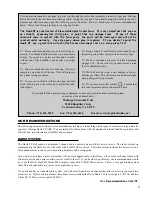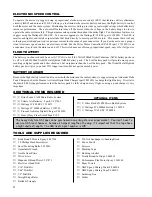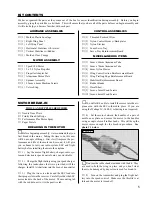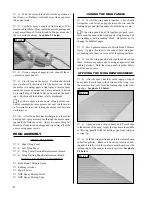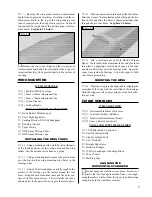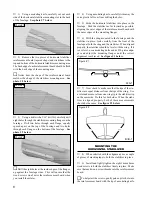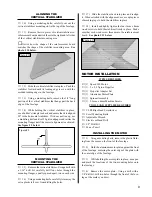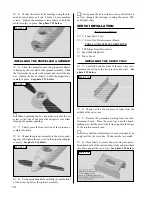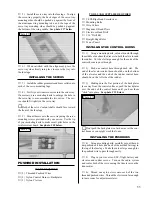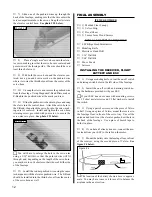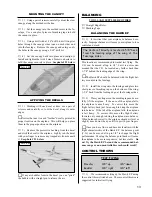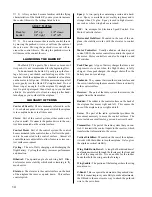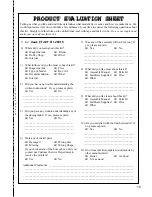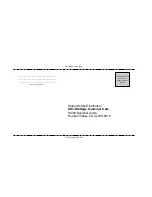
14
❑
3)
You can increase or decrease the control throws
by moving the pushrod wires in or out from the center of
the servo arm. Moving the pushrod wires out will in-
crease the control throws. Moving the pushrod wires in
will decrease the control throws.
LAUNCHING THE HAWK EP
The Hawk EP is a gentle flyer; however, because of
its speed, it is not recommended for the beginning flier.
To hand-launch the hawk EP, gently grasp the fuse-
lage between your thumb and forefingers at the C.G.
location. Hold the airplane above shoulder level and turn
on the motor to full power. With the motor running at full
power, gently toss the Hawk EP straight ahead. Do not
throw it up at an angle. Let the airplane fly straight and
level to pick up airspeed, then climb up to your desired
altitude. Be careful not to climb too steeply after hand-
launching or you could stall the airplane.
❑
2)
After you have become familiar with the flying
characteristics of the Hawk EP, you may want to increase
the control throws to the settings listed below.
SPORT FLYING
Elevator:
1/2 up
1/2 down
Rudder:
1/2 right
1/2 left
GLOSSARY OF TERMS
Center of Gravity: Most commonly referred to as the
C.G. or balance point, it is the point at which the airplane
is in complete balance in all three axes.
Clevis: Part of the control system, either made out of
nylon or metal. It connects the pushrod wire to the con-
trol horn mounted on the control surface.
Control Horn: Part of the control system, the control
horn is mounted to the control surface. It allows the push-
rod to be connected to the control surface. Almost all
control horns are adjustable to allow for more or less con-
trol surface movement.
Cycling: The act of fully charging and discharging the
flight battery. Cycling the battery increases performance
and duration.
Dihedral: The upward angle of each wing half. Dihe-
dral creates more stability which makes learning to fly
much easier.
Elevator: The elevator is the control surface on the back
of the airplane that moves up and down. This surface
controls pitch.
Epoxy: A two-part glue containing a resin and a hard-
ener. Epoxy is available in several drying times and is
stronger than C/A glue. Epoxy is used in high stress ar-
eas such as where wing halves are joined.
ESC: An acronym for Electronic Speed Control. See
Motor Controller below.
Horizontal Stabilizer: Mounted in the rear of the air-
plane, the stabilizer works with the elevator to control
pitch.
Motor Controller: Usually called an electronic speed
control (ESC), the motor controller controls the speed of
the motor. Motor controllers can also be simple on and
off switches.
Peak Charger: A type of battery charger that uses a mi-
croprocessor to sense when the flight battery is fully
charged. Once peak charged, the charger shuts off so the
battery does not overcharge.
Pushrods: They connect between the control surface and
the servo, transferring the movement of the servo directly
to the control surface.
Receiver: The part of the radio system that receives the
signals from the transmitter.
Rudder: The rudder is the control surface on the back of
the airplane that moves right and left. This causes the
nose of the airplane to yaw right and left.
Servo: The part of the radio system that produces the
movement necessary to move the control surfaces. The
servo includes a small motor, gears and a circuit board.
Transmitter: The part of the radio system that you con-
trol. It transmits the control inputs to the receiver, which
transfers that information to the servos.
Vertical Stabilizer: Mounted on the rear of the airplane,
it works with the rudder to turn the airplane. It also gives
the airplane vertical stability.
Wing Hold Down Dowel: A length of hardwood dowel
or aluminum inserted through the fuselage at the front and
back of the wing saddle. It is an anchor for the rubber
bands that hold the wing onto the fuselage.
Wing Saddle: The portion of the fuselage where the wing
mounts on to.
Z-Bend: This is a special bend made in the pushrod wire.
While it cannot improve your ability to make adjustments,
the Z-Bend is the most secure way to attach the pushrod
wire to the servo horn.



